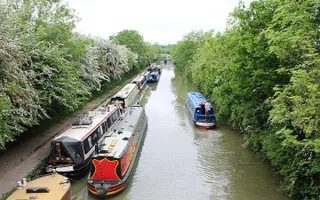A simple check as to whether or not it's ok to double up is to use your eyes and common sense.
Check the width, check the sightlines, check how far you are from any bend, bridge hole, winding hole, lock landing, facilities moorings etc. If it looks like you could cause an obstruction, don't double moor.
The actual shape of most canals is a dish: the edges are much shallower than the central channel. The main channel of deeper water is normally slightly closer to the towpath side. Too many boats moored up on the towpath side extending out into the deeper water can push passing boats onto the offside, where they may run aground. And if you’ve ever met oncoming craft in a tight spot, you’ll appreciate how important sightlines are.
Our customer service team receive complaints every week regarding moored boats obstructing the safe navigation of other vessels. The main causes are triple mooring of narrow beam craft, wide beams on narrowboats (which is effectively triple mooring), and boats moored too close to bridge holes and on lock landings.





